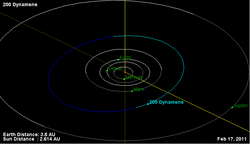Astronomy:200 Dynamene
 Orbital diagram | |
| Discovery | |
|---|---|
| Discovered by | C. H. F. Peters, 1879 |
| Discovery date | 27 July 1879 |
| Designations | |
| (200) Dynamene | |
| Pronunciation | /daɪˈnæmɪniː/[1] |
| A879 OA; 1904 CA; 1955 HZ; 1961 TO1; 1974 HE1 | |
| Minor planet category | Main belt |
| Orbital characteristics[2] | |
| Epoch 31 July 2016 (JD 2457600.5) | |
| Uncertainty parameter 0 | |
| Observation arc | 136.47 yr (49845 d) |
| |{{{apsis}}}|helion}} | 3.1020 astronomical unit|AU (464.05 Gm) |
| |{{{apsis}}}|helion}} | 2.3728 AU (354.97 Gm) |
| 2.7374 AU (409.51 Gm) | |
| Eccentricity | 0.13320 |
| Orbital period | 4.53 yr (1654.3 d) |
| Mean anomaly | 10.506° |
| Mean motion | 0° 13m 3.432s / day |
| Inclination | 6.8957° |
| Longitude of ascending node | 324.57° |
| 85.089° | |
| Earth MOID | 1.39358 AU (208.477 Gm) |
| Jupiter MOID | 2.2934 AU (343.09 Gm) |
| TJupiter | 3.328 |
| Physical characteristics | |
| Dimensions | 128.36±2.1 km[2] 130.71 ± 3.01 km[3] |
| Mass | (1.07 ± 0.16) × 1019 kg[3] |
| Mean density | 9.14 ± 1.51 g/cm3[3] |
| Rotation period | 37.394 h (1.5581 d)[2][4] |
| Geometric albedo | 0.0533±0.002 |
| C | |
| Absolute magnitude (H) | 8.26 |
Dynamene (minor planet designation: 200 Dynamene) is a large dark main-belt asteroid that was discovered by German-American astronomer Christian Heinrich Friedrich Peters on July 27, 1879, in Clinton, New York. The name derives from Dynamene, one of the fifty Nereids in Greek mythology. Based upon its spectrum, 200 Dynamene is classified as a C-type asteroid, indicating that it probably has a primitive composition similar to the carbonaceous chondrite meteorites. The spectra of the asteroid displays evidence of aqueous alteration.[5]
Photometric observations of this asteroid at the Organ Mesa Observatory in Las Cruces, New Mexico in 2011 gave a light curve with a period of 37.394 ± 0.002 hours and a brightness variation of 0.10 ± 0.01 in magnitude. The curve is asymmetrical with four uneven minima and maxima.[4]
Occultation data from October 9, 2006, using 15 chords shows the asteroid is about 130 km in diameter.[6]
References
- ↑ Noah Webster (1884) A Practical Dictionary of the English Language
- ↑ 2.0 2.1 2.2 "200 Dynamene", JPL Small-Body Database Browser (NASA Jet Propulsion Laboratory), https://ssd.jpl.nasa.gov/sbdb.cgi?sstr=200, retrieved 12 May 2016.
- ↑ 3.0 3.1 3.2 Carry, B. (December 2012), "Density of asteroids", Planetary and Space Science 73 (1): 98–118, doi:10.1016/j.pss.2012.03.009, Bibcode: 2012P&SS...73...98C. See Table 1.
- ↑ 4.0 4.1 Pilcher, Frederick (April 2012), "Rotation Period Determinations for 31 Euphrosyne, 65 Cybele, 154 Bertha 177 Irma, 200 Dynamene, 724 Hapag, 880 Herba, and 1470 Carla", The Minor Planet Bulletin 39 (2): 57–60, Bibcode: 2012MPBu...39...57P.
- ↑ Fornasier, S. et al. (February 1999), "Spectroscopic comparison of aqueous altered asteroids with CM2 carbonaceous chondrite meteorites", Astronomy and Astrophysics Supplement 135: 65−73, doi:10.1051/aas:1999161, Bibcode: 1999A&AS..135...65F, https://ui.adsabs.harvard.edu/link_gateway/1999A&AS..135...65F/PUB_PDF.
- ↑ "2006 Asteroid Occultation Reports for North America". IOTA (International Occultation Timing Association). http://www.asteroidoccultation.com/observations/Results/index2006.html. Retrieved 2015-06-08. (chords)
External links
- 200 Dynamene at AstDyS-2, Asteroids—Dynamic Site
- 200 Dynamene at the JPL Small-Body Database
 |

